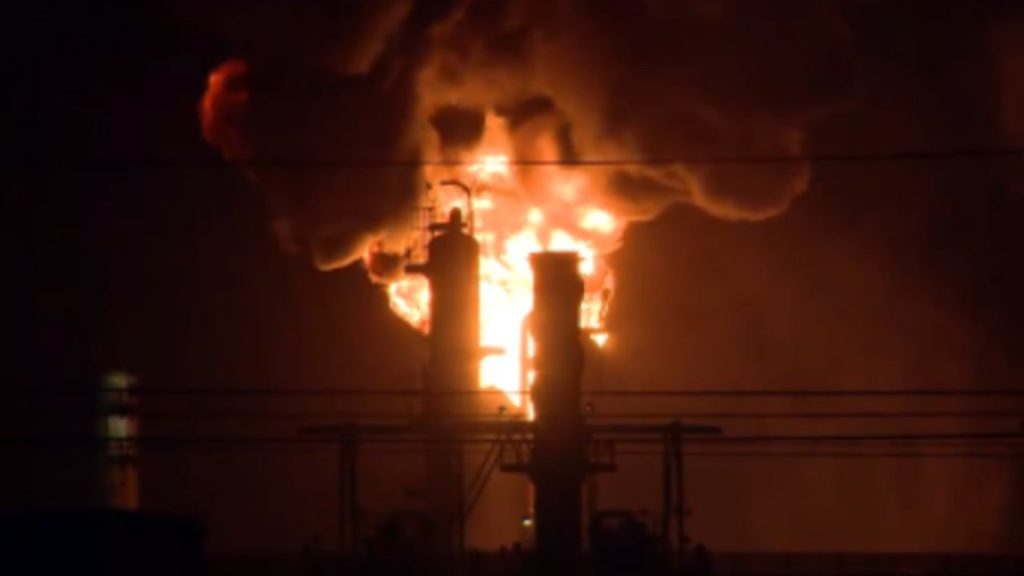Massive Fire Engulfs Southern California’s Chevron Refinery
A dramatic emergency unfolded Thursday evening as a massive fire erupted at the Chevron oil refinery in El Segundo, California, creating a spectacle visible for miles across Los Angeles County’s South Bay area. Emergency responders rushed to the scene around 9:35 PM after multiple calls reported smoke billowing from the facility. The night sky was transformed into an apocalyptic scene as towering flames and thick plumes of smoke rose from the industrial complex, catching the attention of thousands of nearby residents and motorists. Local news outlets, including FOX 11 LA, quickly began covering the developing situation as social media filled with images of the frightening industrial blaze that illuminated the coastline with an ominous orange glow.
The El Segundo refinery, a critical piece of Southern California’s energy infrastructure, processes hundreds of thousands of barrels of crude oil daily and supplies a significant portion of the region’s gasoline, diesel, and jet fuel. Located just south of Los Angeles International Airport and adjacent to residential neighborhoods, the facility’s proximity to populated areas raised immediate concerns about potential evacuations and air quality impacts. As firefighting crews mobilized to battle the intense flames, residents in surrounding communities watched anxiously from their homes, many capturing videos of the fire that rapidly spread across social media platforms. The refinery’s strategic importance to California’s fuel supply also raised questions about possible effects on regional gas prices, especially if the facility faced extended downtime.
At the time of initial reports, critical details about the fire remained unknown, including its cause, extent of damage, and whether any refinery workers or emergency responders had been injured in the incident. Chevron representatives had not yet provided official statements regarding the emergency, leaving many questions unanswered as first responders focused on containing the blaze. The refinery, which operates around the clock with hundreds of employees working various shifts, contains highly flammable materials and complex processing equipment, making firefighting efforts particularly challenging and dangerous. Specialized industrial firefighting teams trained for petroleum fires likely coordinated with local fire departments in the complex emergency response operation.
Industrial accidents at oil refineries present unique hazards that extend beyond the immediate fire danger. Such facilities process volatile hydrocarbons and utilize pressurized systems that can release toxic chemicals when compromised. For this reason, air quality monitoring becomes a critical concern during refinery fires, as combustion byproducts may include harmful substances that can affect surrounding communities. Health officials typically monitor such situations closely, sometimes issuing shelter-in-place advisories depending on wind conditions and the specific materials involved in the fire. The El Segundo facility’s coastal location means prevailing ocean breezes could either help disperse airborne contaminants or potentially carry them toward populated areas, depending on weather conditions at the time.
The El Segundo refinery fire occurs against the backdrop of California’s ongoing challenges with industrial safety and environmental concerns. The state, which maintains some of the nation’s strictest regulations on industrial facilities, has nevertheless experienced several significant refinery incidents in recent decades. These events have often prompted regulatory reviews, safety procedure updates, and community discussions about the balance between economic needs and public safety. For nearby residents, many of whom have lived in the shadow of the refinery for years, such incidents renew concerns about the risks associated with living near major industrial operations, even as these facilities provide essential products and economic benefits to the region.
As investigation into the incident begins, authorities will work to determine not only what triggered the fire but also evaluate the effectiveness of emergency response systems, safety protocols, and community notification procedures. Modern refineries incorporate extensive safety systems designed to prevent and contain fires, including automated shutdowns, fire suppression equipment, and emergency response teams. The findings from this incident will likely inform future safety improvements not only at this facility but potentially across the industry. Meanwhile, the community awaits updates on the situation as firefighters work through the night to bring the blaze under control, hoping for minimal impacts to both human health and the environment from this frightening industrial emergency that lit up Southern California’s night sky.


